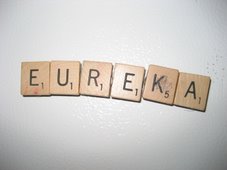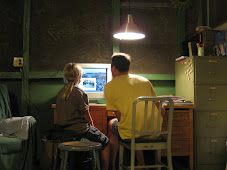We recently did an experiment to discover the value of pi. We did this well before Pi Day, and true to form, we are reporting on it after Pi Day.
Our first experiment measured pi by measuring the diameter and circumference of bean cans. We measured the diameter by putting a ruler across the can and measuring the biggest line across the can. We measured the circumference of the can by putting masking tape around the top of the can, marking the circumference on the tape, removing the tape, and measuring how long the tape was.
C's measurements were
diameter = 10.1 cm
circumference = 31.5 cm
and pi = c/d = 3.12
Sam's measurements were
diameter = 8.55 cm
circumference - 26.6 cm
and pi = 3.11
Not bad!
Our second experiment compared the weight of a square of cardboard to the weight of the circle it contained.
Dad did lots of explaining about ratios, density, and the formula for the area of a circle. After some fabulous and very interesting algebraic manipulation we found out that we could measure pi by comparing the weight of the square of cardboard to the weight of the inscribed circle:
pi = 4 x weight of circle/weight of square
We used a compass to make a circle on some cardboard. We drew a square around the circle using a plastic triangle. Then we cut out the square and weighed it on a junky old scale that has a broken unbreakable cover that covers the needle. The square weighed 1 5/8 ounces. Next we cut the corners off to make a circle and weighed the circle. The circle weighed 1 3/8 ounces. Using the formula above we calculated pi:
pi = 3.38
Not as good. We discussed why our first experiment gave us a better value for pi. C concluded that the ruler worked better than the scale, because the ruler actually works. Dad would like to note that it would be interesting to repeat part 2 with a heavier material or a more sensitive scale.
skip to main |
skip to sidebar


Where will their adventures take them?

We moved to www.eurekafamily.blogspot.com in June 2011

TinTin and Snowy

Where will their adventures take them?

About Us
- C =Boy, aged 13, K=Girl (AKA Kit), aged 11, Mom & Dad
- We are a couple of kids in the southern Sierra Foothills. We (used to) homeschool and like to travel and do other stuff kids like to do. We also like to ride bikes. We named our Blog "Eureka!" because that's what Tintin says when he discovers something, and its the slogan for our state, California. (And, Mom made us do it.)
Our Pets
- Acrobat (chicken)
- Bertha (chicken) (RIP)
- Cedar (chick)
- Chessie the superkitten! aka Fuzzo or Baby Bookins
- Chipper (chick) (RIP)
- Glay (chickenRIP)
- Lulu (dog who thinks she's a cat)
- Pecker & Blackie (twin chickens)
- Poppy (chicken)
- Pumpkin (chicken)
- Rodher (Chicken)
- Sneezer (chick) (RIP)
- Toeser (scaredy cat)
- Weechee (ladybug) (probably dead)
- Whiner RIP (cat who thought she was a dog)
- Witchking (chick) (RIP)
Favorite Movies
- Strange Brew
- Harry Potter Series (both of us)
- Star Wars Series (C)
- Strange Brew
- Lord of the Rings
Favorite Books
- Ranger's Apprenticee
- Percy Jackson
- Sammy Keyes
- The Floating Island
- Hitchhiker's Guide to the Galaxy
- Captain Bluebear
- Lord of the RIngs
- Harry Potter Series